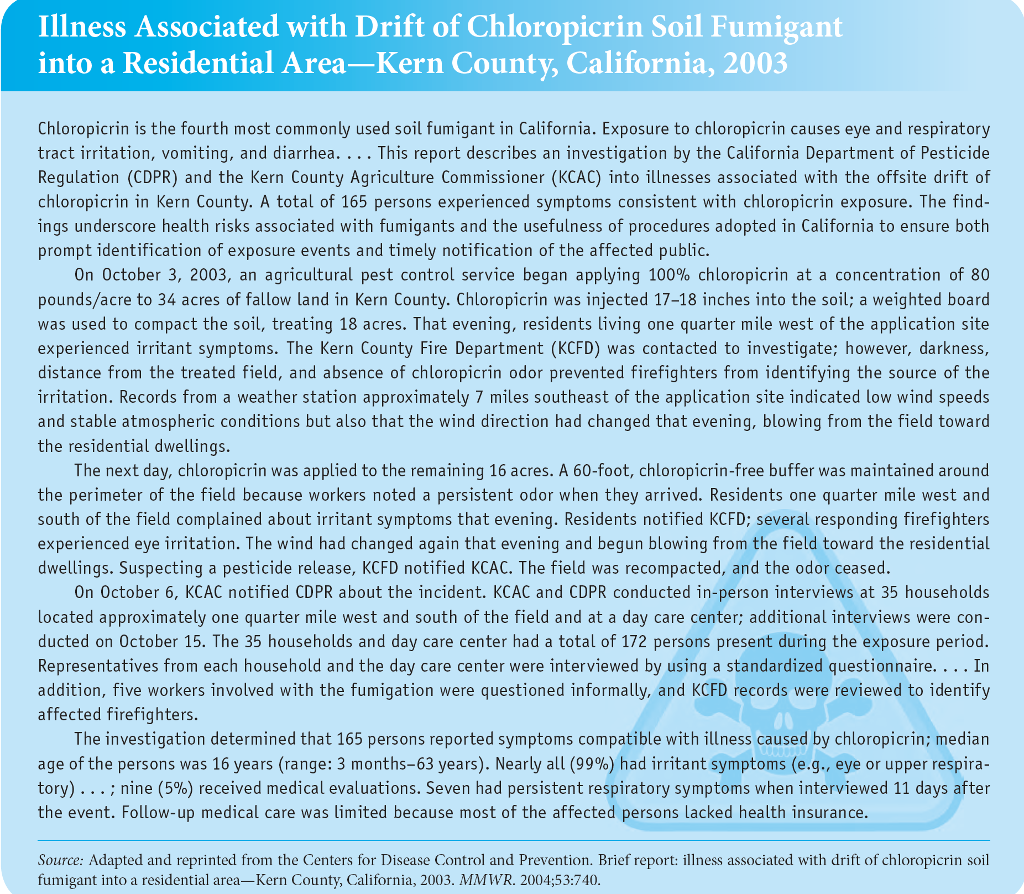Illness Associated with Drift of Chloropicrin Soil Fumigant into a Residential Area-Kern County, California, 2003 Chloropicrin is the fourth most commonly used soil fumigant in California. Exposure to chloropicrin causes eye and respiratory tract irritation, vomiting, and diarrhea Regulation (CDPR) and the Kern County Agr chl ings underscore health risks associated with fumigants and the usefulness of procedures adopted in California to ensure both prompt identification of exposure events and timely notification of the affected public This report describes an investigation by the California Department of Pesticide Comm1 KCAC ed with the site drift l of 165 pers expe ed symptoms consistent with chloropicrin exposure. The find- On October 3, 2003, an agricultural pest control service began
 Directions: Use the case study to provide answers to the following questions. Case Study: “Illness Associated with Drift of Chloropicrin Soil Fumigant into a Residential Area—Kern County, California, 2003,” located on p. 154 of the textbook 1. Issue Identification a. What is causing the identified problem? b. Why is the problem a problem? c. How was the problem initially identified? d. What are the public perceptions of the hazard? 2. Hazard Identification a. What types of adverse health effects might be caused by the problem? b. How quickly and for what duration might the problem be experienced? 3. Dose Response Assessment a. Evaluate both qualitative and quantitative toxicity information to estimate the incidence of adverse effects occurring in humans at different exposure levels. 4. Exposure Assessment for the Relevant Population a. Determine the frequency, magnitude, extent, duration, and character of exposures to the hazard. 5. Risk Characterization a. Detail the nature and potential incidence of effects for the exposure conditions described in the exposure assessment.
Directions: Use the case study to provide answers to the following questions. Case Study: “Illness Associated with Drift of Chloropicrin Soil Fumigant into a Residential Area—Kern County, California, 2003,” located on p. 154 of the textbook 1. Issue Identification a. What is causing the identified problem? b. Why is the problem a problem? c. How was the problem initially identified? d. What are the public perceptions of the hazard? 2. Hazard Identification a. What types of adverse health effects might be caused by the problem? b. How quickly and for what duration might the problem be experienced? 3. Dose Response Assessment a. Evaluate both qualitative and quantitative toxicity information to estimate the incidence of adverse effects occurring in humans at different exposure levels. 4. Exposure Assessment for the Relevant Population a. Determine the frequency, magnitude, extent, duration, and character of exposures to the hazard. 5. Risk Characterization a. Detail the nature and potential incidence of effects for the exposure conditions described in the exposure assessment.
Transcribed Image Text from this Question
The post Illness Associated with Drift of Chloropicrin Soil Fumigant into a Residential Area-Kern County, California, 2003 Chloropicrin is the fourth most commonly used soil fumigant in California. Exposure to chloropicrin causes eye and respiratory tract irritation, vomiting, and diarrhea Regulation (CDPR) and the Kern County Agr chl ings underscore health risks associated with fumigants and the usefulness of procedures adopted in California to ensure both prompt identification of exposure events and timely notification of the affected public This report describes an investigation by the California Department of Pesticide Comm1 KCAC ed with the site drift l of 165 pers expe ed symptoms consistent with chloropicrin exposure. The find- On October 3, 2003, an agricultural pest control service began appeared first on commompapers.org.